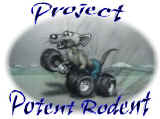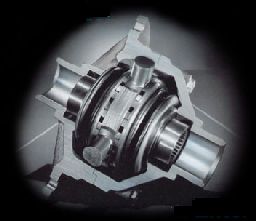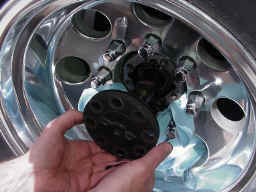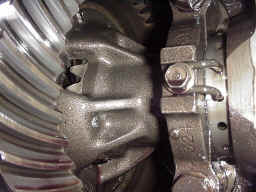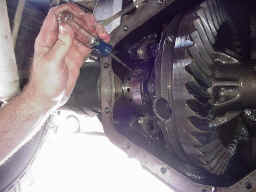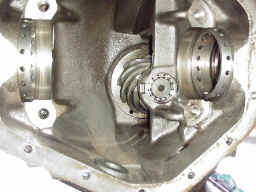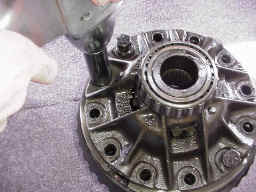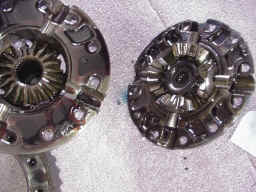A locker like the Detroit is needed since most factory 4wd trucks are sold with "open" differentials. The differential is a device inside the axles that allows one wheel to turn faster than the other. An "open" differential is good for driving on the street but on the trail because it directs engine power to the wheel with the least traction. Without locking differentials it would difficult to drive forward (up the hill) as the right front and left rear wheel would spin free and the other two wheels wouldn't receive any power at all. Replacing the stock differential with a locking unit solves this problem and keeps the wheels turning together.
|
Click picture for larger image |
|
The Detroit Locker offers strength and durability. The downsides to this locker is the snapping feeling when it re-engages after corners. |
Some trucks are available with limited slip differentials (LSD) as a factory option. These units help move power form the wheel that is spinning to the one that is not spinning by means of internal clutches. LSD's are great in street and occasional off road situations but do not provide 100% lock-up that results from using a true locker like the Detoit. Limited slip differentials of both gear and clutch types will transfer only a fraction of the available torque to the side that is not slipping. This is not as good as a locker, but may be enough to get you through. Limited slip differentials are not suitable for use in the front axle of a vehicle with an axle disconnect.
When driving in a straight line the Detroit locker is normally locked. On dry pavement, when cornering, the outer wheel over-running the speed of the axle unlocks the outside axle shaft. Power is applied to the inside wheel only. This can cause a noticeable under-steer. Additionally, if enough power is applied while in the turn, the axle will lock up and the vehicle either slips wildly, spins or straightens out suddenly. These differentials sometimes make a clicking noise when cornering; some find this objectionable. Now... after the corner and the locker re-engages, you can expect to feel a loud BANG. This may also cause a steering jerk. When this first happened after the installation, we were expecting to see parts behind us since we didn't know what happened. We soon found this to be a normal charactoristic of the locker.
On the trail, this locker kicks some booty! It took the beating of the 454 and came back for more. There's a couple times we dropped the dual friction clutch and let her rip and had zero problems. It never let one tire slip like a LSD would. You can be assured this locker will keep you from grabbing the winch controller.
This type of locker is not suitable for front axle use in vehicles with disconnect axles in the front. Disconnect axles are used on the front end of some newer vehicles. They are considered by some a nice feature and by others a terrible fault. They are used with "shift on the fly" four wheel drive. It basically separates the right side axle shaft. Locking hubs are not used with this arrangement. The problems with using lockers with such axles are that the drive shaft will be driven and that the side not split by the disconnect will undergo drag, especially when the differential is cold. This will cause a pull toward the side of the front axle that the differential is on. Installation:
Installation of the Detroit locker is quite simple. The locker replaces the spider gears and no carrier had to be purchased for our application.
-
First we started by removing the diff cover.
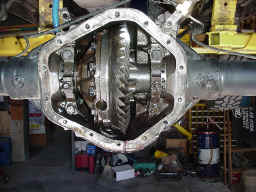
Click picture for larger image |
Click picture for larger image |
| The diff cover is removed. | The FF shafts are removed next. |
-
The axle shafts are removed next. A rag or pan should be placed underneath to catch the gear oil.
-
Instead of shims on each side of the carrier, the 14 bolt has large nuts with small holes in the round nut. The nut is scribed with the housing. This is to ensure the lash will be the same when the job is complete. You will have to pay close attention when turning these nuts to note how many turns each nut made. It's also a good idea to not the bearing caps so they won't get mixed up.
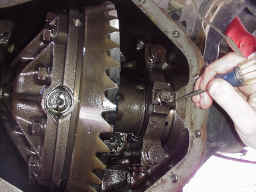
Click picture for larger image |
Click picture for larger image |
| Marks are scribed to note the exact the position of the adjusting nuts. | These 2 prong keepers need to be removed next. |
-
The nuts have small 2 prong keepers that prevent them from turning. These keepers must be removed.
-
The bearing caps are then removed. Again, make sure to note the right and left sides and which end goes up.
-
The differential nuts can then be loosened. Pay close to attention on how many times each nut turns. 3 or 4 turns on each nut and the carrier should come out. Be extra careful the carrier doesn't come out un-expected and hold it in place until you're ready. After the carrier is out, the inside of the housing should be cleaned. We used brake cleaner for this.
-
When you take the carrier out, place some rags on the ground since it will covered in oil. Try to keep it clean. The ring gear needs to be removed next. An impact wrench works the best for removing the bolts. After the ring bolts are removed, the carrier should come apart to expose the spider gears.
-
The spider gears are removed to make room for the Detroit locker. The new locker is installed. Be sure to keep the retaining bolt on the locker and don't remove it until the carrier is back together.
-
The carrier is then put back to together. The bearings and races are checked for any burn marks or wear. If wear is evident, you should replace them. This will require a bearing puller if they need replaced.
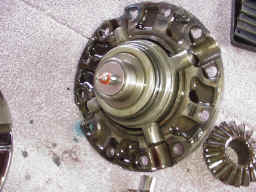
Click picture for larger image |
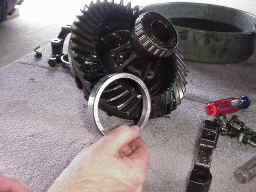
Click picture for larger image |
| The Detroit locker is installed. | Both bearins and each race is checked for wear or burn marks. |
- The carrier is then installed back into the pumpkin. The adjusting nuts are then carefully turned the same amount of turns when the carrier was removed. The bearing caps are then installed along with the two prong keepers. The bearing caps are then torqued to the proper specs. The diff cover is installed with a new gasket and some RTV silicone.
You will notice some differences compared to driving with a conventional differential.
Turning: An occasional snapping/ loud metallic sound may be heard due to component disengagement and re-engagement. This may be noticeable in the feel of steering. When corners are taken the locker will disengage but when it re-engages, it snaps making a loud sound and sometimes causes the steering to jerk.
Drive-to-Coast: A metallic sound may be heard due to the normal backlash built into the unit.
Slippery Roads: Vehicles equipped with a Detroit locker are inherently more sensitive to side slip. Caution must be taken when changing speed on slippery or unstable surfaces.
If a Detroit locker is installed in the front, it will be difficult while driving on hard surface roads. Turning will be difficult and it may pull to one side when going straight. This locker isn't suggested if the vehicle will be driven on icy or snow packed roads.
Questions or Comments about this page should be directed to:
chevy@off-road.com.
We cannot guarantee a response to every letter we receive.
